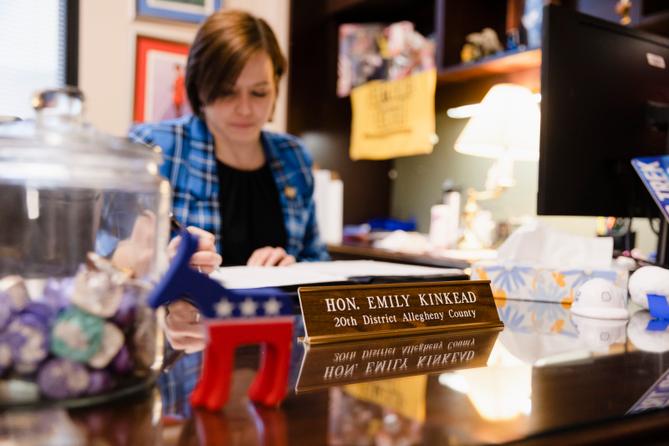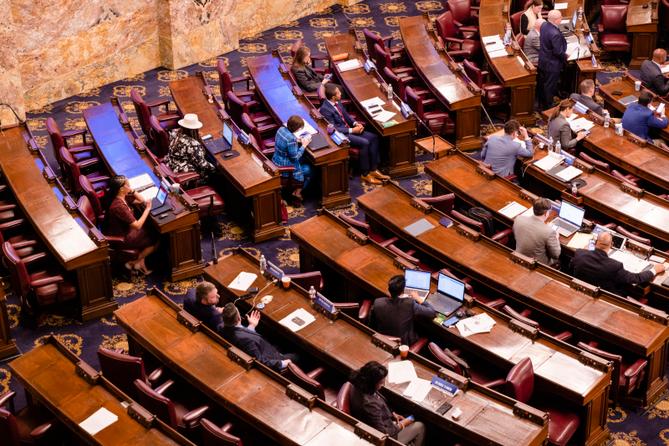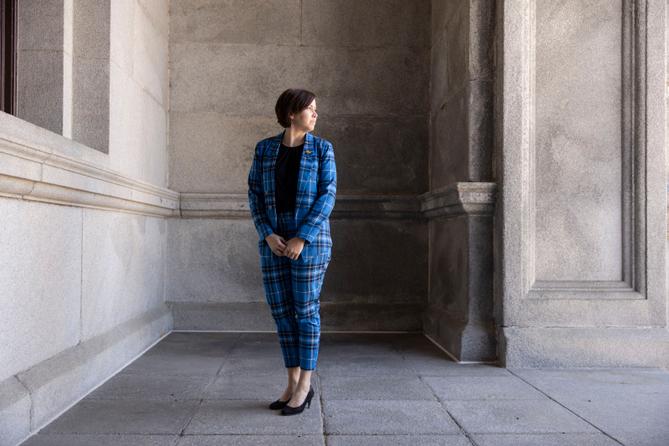Spotlight PA is an independent, nonpartisan newsroom powered by The Philadelphia Inquirer in partnership with PennLive/The Patriot-News, TribLIVE/Pittsburgh Tribune-Review, and WITF Public Media. Sign up for our free newsletters.
HARRISBURG — When Emily Kinkead asked Lisa Bennington for advice on running for elected office, the former Pennsylvania state lawmaker gave blunt words of warning:
“Don’t run, you’re so smart. There’s so many other things you can do.”
Bennington, a Democrat, won an Allegheny County state House seat in 2006 but only served one term before retiring and returning to family law. She said the “paternalistic” culture of the legislature and its deference to seniority kept her from achieving her legislative priorities.
“I just found it very corrupt, very old boys’ club,” Bennington said. She never got to accomplish goals like bolstering access to emergency contraception for rape victims or expanding the statute of limitations for victims of childhood assault.
Kinkead ended up running anyway, and won a state House seat to represent part of the Pittsburgh suburbs in 2020. The Democrat said when she got to the chamber, she found a very different place from the old boys’ club Bennington experienced more than a decade ago.
“There’s definitely been a change in the number of women that are around and the kinds of men that are elected,” Kinkead said.
But the state legislature remains far from perfect for women, Kinkead said, pointing to the recent resignation of state Rep. Mike Zabel (D., Delaware) after multiple people, including fellow lawmakers, accused him of sexual harassment.
“There’s definitely stuff that’s still ongoing,” she said.

A century after the first women were elected to Pennsylvania’s state legislature, both chambers now have women at their helm — Republican President Pro Tempore Kim Ward in the state Senate, and Democratic Speaker Joanna McClinton in the state House.
However, less than one-third of the members of the state legislature are women — 80 of the 253 lawmakers who serve in the state House and Senate. That puts the commonwealth 27th in the country for the percentage of women in its legislature.
Eight women who are or used to be state lawmakers spoke to Spotlight PA for this story, and many agreed that having more women in the state legislature fundamentally reshapes policy debates, particularly on issues like education, care for children and older adults, and equal pay.
“As a person of color, but as a woman in particular, that burden falls on us a lot to have to educate our colleagues,” said state Rep. Donna Bullock (D., Philadelphia), who chairs the Pennsylvania Legislative Black Caucus.
She noted that two-thirds of people earning minimum wage in the state are women, and pointed to recent legislative efforts to fight hair discrimination, which predominantly affects Black women. Bullock said she felt she had to explain to some of her colleagues “what it means to be a [Pennsylvania] woman.”
“Pennsylvania women are our workers, they are providing for their households, they are people who are working minimum wage,” Bullock said.
Contending with ‘gatekeepers’
Women’s legislative strength has grown in fits and starts in Pennsylvania.
In 1975, only seven women served in the state House and Senate. That number has slowly ticked upward since, but the biggest growth came in a few key years — most notably, 1992 and 2018.
A wave of women ran for and were elected to office in 1992, a year after the confirmation hearings of U.S. Supreme Court Justice Clarence Thomas, who was accused of sexual harassment. Nine women joined the Pennsylvania legislature at that time.
The 2018 spike, in which nearly 20 women joined the Pennsylvania legislature, was the largest gain of women in the state legislature in the past five decades. It came two years after former President Donald Trump’s election set off a wave of Democratic organizing, especially among women.
In their conversations with Spotlight PA, lawmakers and academics agreed that the number of women in Pennsylvania’s legislature has remained middling at least partly because the party apparatuses that identify and groom candidates for success still struggle to see women as viable candidates.
At the county level, party organizations typically identify potential candidates for elected office and hand out endorsements based on a range of criteria, like perceived appeal or party loyalty. In low-participation elections, that endorsement can go a long way when voters are choosing between candidates with little name recognition.
“You have gatekeepers who make endorsements and play an outsize role,” said Debbie Walsh, director of Rutgers University’s Center for American Women and Politics. “If the presumption is that Black women or Latinas or Asian women can’t get elected, then the recruitment doesn’t happen and money doesn’t flow.”
Walsh noted that Pennsylvania has “very strong political parties” compared to other states.
Of the eight current and former lawmakers who spoke to Spotlight PA for this story, only three were endorsed by their party when they first ran for office.
When state Sen. Lisa Boscola (D., Lehigh) first ran for a state House seat in 1994, she did so without her county Democratic party’s endorsement and had to loan herself funds to run her campaign. Boscola said that Lehigh Valley party leaders discouraged her from running, as they felt she hadn’t “paid her dues.”
When she joined the state House, Boscola said she felt isolated at first, recounting that male colleagues would pat her on the head and tell her, “the less you say, the longer you’ll stay.”
“When you’re a man and you get into the legislature, you’re right up there with them. For women, you start below that and you have to earn that,” Boscola said. “I do see that women are having an easier time now and they’re more accepted because the number has grown so much … They can’t ignore us anymore.”
While the number of women overall has grown, the number of women of color in the state legislature has remained relatively flat.
Pennsylvania elected its first woman of color to the legislature in 1938, the first in the country. Philadelphia civil rights activist Crystal Bird Fauset, a Democrat, was at that time the first Black woman elected to any legislature in the country, according to the Center for American Women and Politics.
But after Fauset resigned a year later, women of color were completely absent from the legislature until 1984, when Philadelphia Democrat Roxanne Jones won a seat in the state Senate.
In the decades since, the number of women of color in the legislature has crept up slowly. In 1995, there were four; in 2005, six. Currently, there are no women of color in the state Senate. The state House, meanwhile, has an all-time high of 12 women of color — still less than 5% of the entire chamber.
Bullock thinks the slow growth in these numbers shows that big political donors, not just the party establishment, have long been wary about betting on women of color.
“The issue becomes, those who financially support campaigns … tend to still be predominantly men,” Bullock said. “If you can’t fundraise, the party and other institutions that would get behind you will consider that as an indicator that you’re not a viable candidate.”
State Rep. Tina Pickett (R., Bradford) echoed Bullock, saying that when she first ran in 2000, she also felt it was more difficult for female candidates to fundraise than their male counterparts. But she thinks that it has become easier over time.
“When I first came in, it was very difficult for women to fundraise,” she said. “At a fundraising function, you might see a check written to support the campaign of a man be double or triple what someone might write to support a woman’s campaign.”
A shrinking confidence gap
In last year’s election cycle, one of the most expensive races in the commonwealth involved Melissa Cerrato (D., Montgomery), who was seeking to flip a GOP-held seat that Democrats needed to win to take control of the chamber.
After winning an endorsement from county officials, Cerrato received hundreds of thousands of dollars in donations from the state Democratic party, local party organizations, and special interest groups.
Cerrato said she hasn’t been treated any differently because of her gender since she arrived for work in the state House. But she noted there are small things that make the lives of female lawmakers, particularly mothers, more difficult.

Cerrato pointed to last-minute changes to committee schedules that have forced her to find child care options in a matter of hours. She said she was coordinating with other female lawmakers in the legislature to organize child care in the Capitol during budget hearings.
“It’s not something that most men who have been in the position have had to face or deal with,” Cerrato said. “They’re not used to thinking that way.”
Kimberly Adams, a political science professor at East Stroudsburg University of Pennsylvania, argues that along with structural party issues, lack of confidence may have historically played a role in keeping women from running for office. Some studies, she noted, have suggested that a confidence gap makes women feel they need to be more qualified in order to run for office than men do.
“Women felt like they had to be perfect to run for office,” said Adams, who added that things seem to be changing.
“I don’t see that anymore,” she said.
Adams pointed to the rise of organizations that seek out women candidates to run for office. One such group is Represent PA, a political action committee that donates to female candidates who want to protect abortion access. Last year, the group spent over $700,000 supporting candidates running for positions in the state legislature.
State Sen. Tracy Pennycuick (R., Berks) said she definitely noticed a confidence gap when she joined the state House in 2021 — particularly because there are relatively few senior female lawmakers who can show new ones the ropes.
“It’s hard to find those mentors,” Pennycuick said. “But we’re getting there.”
State Rep. Valerie Gaydos (R., Allegheny) noted that the true measure of women’s influence on state politics and policy goes beyond the tally of elected women. In her time in Harrisburg, she said the most significant change she’s seen is in the number of women working as prominent staffers, such as executive directors of committees or legislative chiefs of staff.
Gaydos was elected to the state House in 2018, but she first worked in the legislature as a staffer for the state Senate Republican caucus in the early ‘90s.
She described a change in “tone” when she returned to the legislature, in large part because she sees more women involved at every level of legislating.
“The legislature has reflected what we’ve seen in culture overall. More women are in the workplace, they have more years of experience … Women [now] see running for office as an option,” Gaydos said. “We don’t need the hurdles removed for us, we just want to figure out how to jump them.”
WHILE YOU’RE HERE… If you learned something from this story, pay it forward and become a member of Spotlight PA so someone else can in the future at spotlightpa.org/donate. Spotlight PA is funded by foundations and readers like you who are committed to accountability journalism that gets results.

